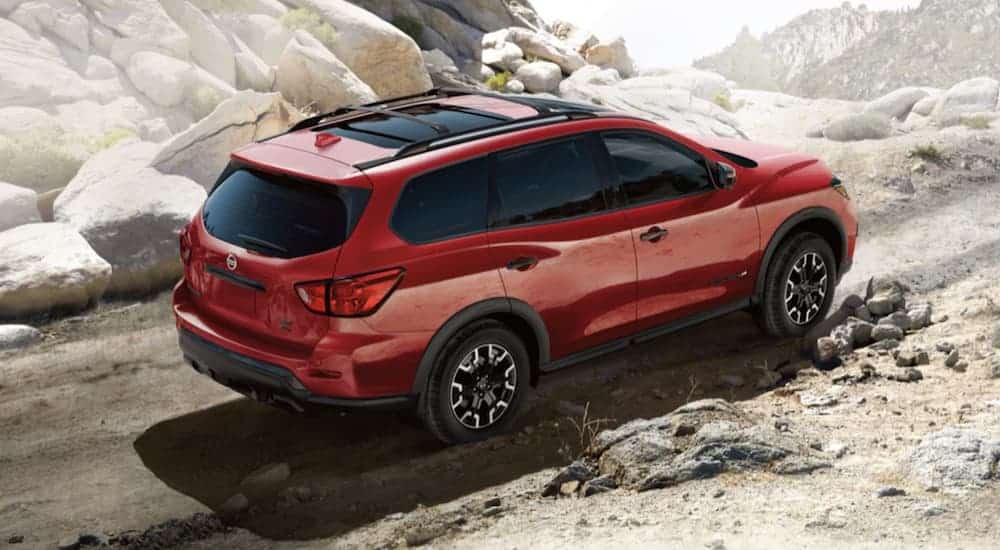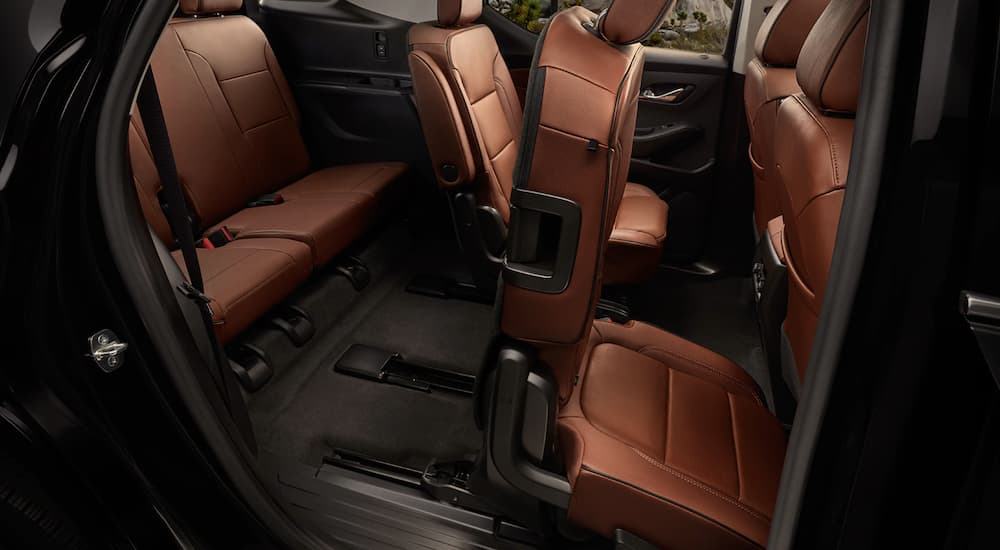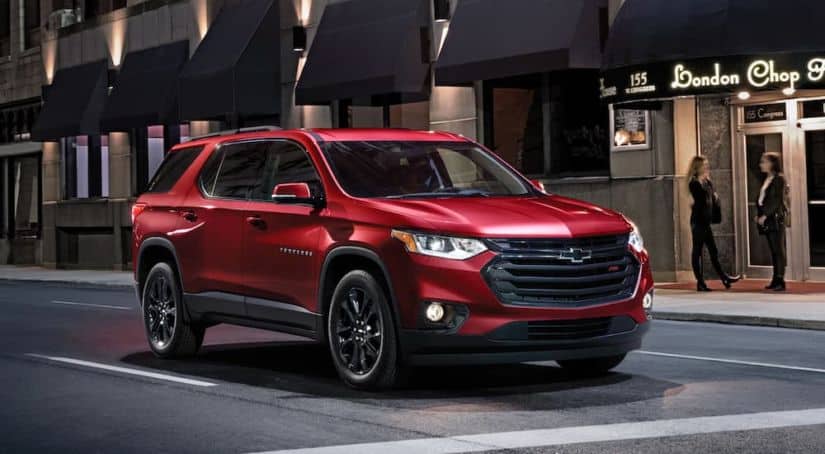For many years, drivers who wanted to buy a vehicle that could seat more than five passengers only had the choices of a passenger van or a full-size SUV. But most drivers are just not comfortable driving a very large vehicle. They require longer stopping distances, don’t fit into most parking spaces, and need more swing in order to corner around sharp turns. As a result, automakers decided to begin adding a third row of seats to their midsize SUVs. The idea behind this is to expand the seating capacity of these vehicles without increasing their size. Some have been more successful than others in making this adjustment. Two of the most popular three-row midsize SUVs on the market are made by Chevy and Nissan. But, what makes them so popular, and which one is better? Well, there are several key differences between the two, which we will explore today as we compare the 2020 Chevy Traverse vs 2020 Nissan Pathfinder.
A Look at Trims and Prices
Both the 2020 Chevy Traverse and the 2020 Nissan Pathfinder offer a number of different trims. The base model Traverse is the L with an MSRP of $29,800. The LS follows this with an MSRP of $32,900, the LT Cloth with an MSRP of $35,400, the LT Leather with an MSRP of $39,100, the RS with an MSRP of $43,600, the Premier with an MSRP of $45,800, and the top-of-the-line High Country with an MSRP of $50,900. The L, LS, and LT Cloth have fabric interiors, while the LT Leather, RS, Premier, and High Country have leather interiors.
The base model 2020 Nissan Pathfinder is the S with an MSRP of $31,680. This is followed by the SV with an MSRP of $34,470, the SL with an MSRP of $38,090, and the top trim, Platinum, with an MSRP of $42,920. The S and SV have cloth seats, while the SL and the Platinum have leather seats.
As you can see, Chevrolet offers the Traverse in seven different trims compared to the four offered for the Nissan Pathfinder. Additionally, the Traverse comes in at a lower starting price, making it the better choice as far as value and options.

What About Performance?
The 2020 Chevy Traverse and the 2020 Nissan Pathfinder both offer only one engine option. The Traverse is equipped with a 3.6-liter V6 gas engine with Variable Valve Timing and Auto Stop/Start. The engine has been rated to produce up to 310 horsepower and 266 lb-ft of torque and is paired with a 9-speed automatic transmission. The Variable Valve Timing and Auto Stop/Start work to improve the engine’s efficiency, the latter actually turns the engine off when you come to a stop at a red light, and then automatically restarts the engine when you take your foot off the brake pedal. The EPA has estimated that the front-wheel drive Traverse will deliver 18 miles per gallon in city driving and 27 miles per gallon on the highway, which is very solid for a vehicle of its size.
The 2020 Nissan Pathfinder features a 3.5-liter Direct Injection DOHC 24-valve V6 gas engine. This is paired with Nissan’s CVTCS, a continuous variable valve timing control system. Rather than having specific gear speeds, the CVTCS continuously adjusts the transmission to fit the specific driving conditions. The engine on the Pathfinder provides up to 284 horsepower and 259 lb-ft of torque. The front-wheel drive Pathfinder has been estimated to deliver 20 miles per gallon in city driving and 27 miles per gallon in highway driving.
While the Pathfinder provides slightly better fuel economy, this comes at a price. The smaller, less powerful engine on the Pathfinder means that it will not have the pickup or overall speed of the Traverse. In addition, there have been complaints that the CVTCS leads to a choppier ride as it is constantly adjusting the transmission’s timing to provide more fuel efficiency. So, with all of that in mind, especially the horsepower and torque ratings, it is safe to say that the Traverse continues taking the lead in the area of performance.
Room For Friends?
The most important reason for buying a three-row midsize SUV is seating capacity. That third row is there for a reason, and it is to give you the ability to fit more than five passengers. The Traverse does a better job of doing this than the Pathfinder. The 2020 Traverse L, LS, LT Cloth, and LT Leather have room for up to eight passengers, while the RS, Premier, and High Country can fit up to seven passengers. All trims of the 2020 Nissan Pathfinder only have room for seven passengers.
In addition, the Traverse does a better job of seating these passengers. First and second-row passengers in both vehicles have comparable space. The Traverse provides 40 inches of headroom (39.6 inches with a sunroof), 41 inches of legroom, and 62.1 inches of shoulder room for front-row passengers, and 40 inches of headroom, 38.4 inches of legroom, and 62.2 inches of shoulder room for second-row passengers. This is similar to the Pathfinder, which provides 42.2 inches of headroom (41.1 inches with a sunroof), 42.2 inches of legroom, and 60.9 inches of shoulder room to front-row passengers, and 39.4 inches of headroom, 41.7 inches of legroom, and 60.4 inches of shoulder room to second-row passengers. The problem occurs with the third row.
The Traverse provides plenty of room for its two or three passengers in the third row, fully 38.2 inches of headroom, 33.5 inches of legroom, and 57.5 inches of shoulder room. This is not the case with the Pathfinder, where third-row passengers have 37.8 inches of headroom, a cramped 19.8 inches of legroom, and 57.1 inches of shoulder room. That legroom figure shows that the third row is pretty much an afterthought on the Pathfinder, with only enough room for a small child. All of this said, the Traverse, again, comes out on top.

Cargo space
In addition to having a more efficient distribution of passenger space among its three rows, the 2020 Chevy Traverse actually provides more room for cargo than the 2020 Nissan Pathfinder. This applies in all three scenarios: all three seats up, third row down, and second row down. The 2020 Chevy Traverse has 23 cubic feet of cargo space in its trunk, 57.8 cubic feet of cargo space with the third row down, and a huge 98.2 cubic feet of cargo space with the second row down as well.
The 2020 Nissan Pathfinder only has 16.2 cubic feet of cargo space in its trunk, 47.4 cubic feet of cargo space with the third row of seats down, and 79.5 cubic feet of cargo space with the second row of seats folded down as well. Clearly, if you are looking to move stuff with your midsize SUV, there is really only one choice here, the Traverse.
It’s the Chevy Traverse
It is evident that the 2020 Chevy Traverse comes out on top no matter which way we look at it. With a lower price point, more trims, a stronger engine, and more space for friends, family, and your things, there is no denying that the winner of the 2020 Chevy Traverse vs 2020 Nissan Pathfinder comparison, is the Chevy Traverse.



